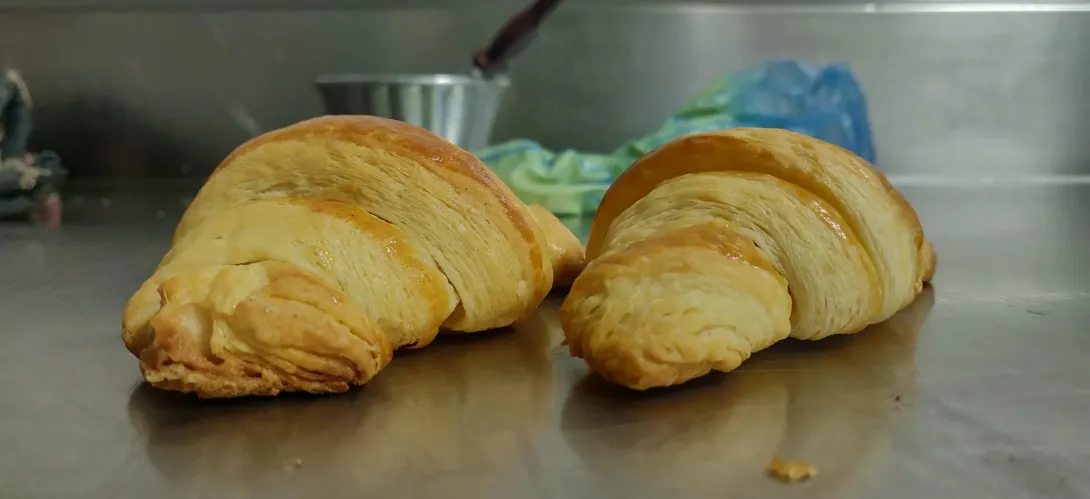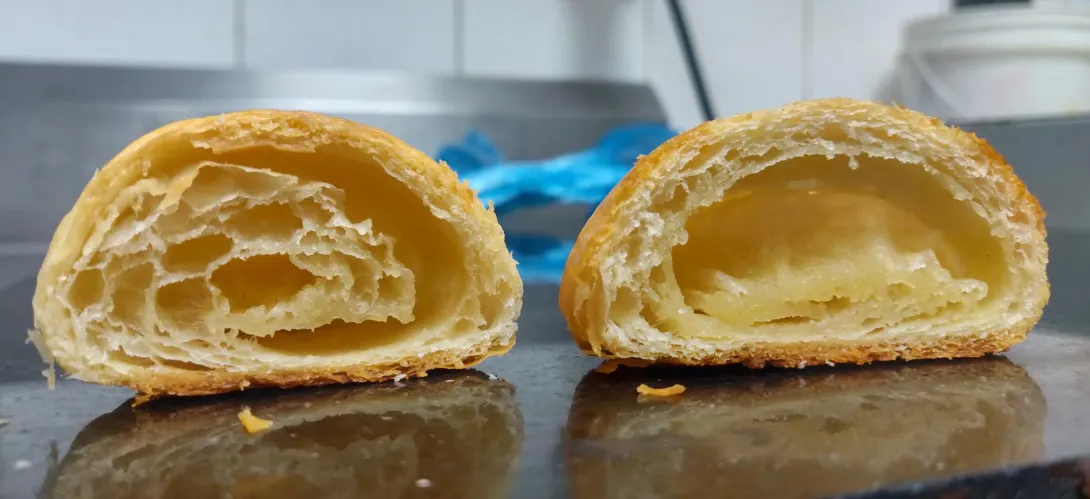
I'm a professional baker, recently moved to Thimphu, Bhutan. Used to achieve perfect croissants with beautiful honeycomb back in Mumbai, but despite multiple attempts, I'm just not getting the same results over here. Below is a full breakdown of my recipe and method, please tell me where I'm going wrong.
Bread flour (White Swan brand) 1000g
Sugar 110g
Yeast (Instant dry) 15g
Gluten 12g
Bread improver 15g
Salt 20g
Honey 15g
Butter 200g
Water 440-450g (depending on humidity and dough consistency)
I make my dough, rest it for 30 mins, divide into 1kg blocks and freeze for about 4-5 hours, till it's the right consistency for lamination.
For each 1kg block, I use 330g of unsalted butter (my only option for the butter is a local one, the other butters I get are all salted), which has been shaped into a slab and chilled.
After enclosing the butter, I do one single fold and rest the dough in the freezer for 20 mins to firm up. Then I do another 2 single folds for a total of 3 single folds, giving me 27 layers of butter. I used to do 1 single, 1 double earlier, but found I'm getting better layers and texture with 3 singles.
Once laminated, I freeze the block for use the next day.
The following day, I let the dough thaw out at room temperature, roll to 5mm thickness (my dough sheeter is ancient and destroys my dough if I try going any thinner). I've tried rolling it even thinner by hand after this, but the dough just resists too much, even if I rest it in the chiller in between.
I cut my croissants with a 7cm base and 18cm length, dust off any excess flour, stretch the triangle a little, notch the centre of the base and roll up the croissants. d
This is done by 6pm on day 2.
The shaped croissants then go into the chiller. My night shift staff pulls the croissant out by 2am, and leaves them in the switched off proofing chamber.
On day 3, I come in by 6am, by which time the croissants are seemingly perfectly proofed. I use an egg wash, and bake at 190°C for 18 mins, then switch off the heating and let the croissants "dry" out for 2-3 mins.
The croissants get a beautiful oven spring in the first 9-10 mins of baking, and subsequently they start to slowly deflate till they reach the shape you see in the picture.
I used to bake at 220°-230°C in Mumbai, but out here at that temperature, the croissants get colour way too quickly and the insides remain raw.

The one on the left is rolled to the absolute thinnest I can manage on my dough sheeter, around 4mm maybe, and the one on the right is hand rolled, doesn't go below 5-6mm. So clearly the thickness does contribute to the problem, but as you can see, even the thinner one has a doughy bit in the centre.
Are there any other parameters I need to change or is it just the thickness that's the source of all my problems? And yes, I'm trying to source a good quality "French-style" or "dry butter" but will that make a difference?
- tarjr_253's Blog
- Log in or register to post comments
Have you considered the altitude difference?
I live in Colorado, at about 1,700 meters. So the air pressure is lower and water boils at a lower temperature compared to sea level.
Mumbai's at about 14 meters, you're now at about 2,248 meters.
Steam's going to be produced at a lower temperature, 92.5C, rather than 100 C in Mumbai, so results are going to vary from what you are used to. Put another way, the steam is going to convey/produce less energy because it's cooler.
Same issue if you try to boil pasta at altitude. It will take much longer at altitude than at sea level because the water's boiling at a lower temperature. I once live at 2,777 meters in Colorado, so I have some familiarity with the differences/problems of cooking and baking at altitude.
I recommend you google 'high altitude baking tips' for suggestions of what to try.
Thanks Jerry, I already did that before moving to Thimphu. My original recipe called for the detrempe to be made with water + milk, which was becoming too rich. As you rightly said, the steam here is actually at a lower temperature, and so my first few batches turned out almost like laminated cake.
I connected with a few pastry chefs that I've worked with, sent them photos and with their help, made the right adjustments. Just replacing the milk with water made a huge difference.
I then realised that the local butter had too low a moisture content, so I did some calculations and now settled on the following as the formula for my laminating butter:
For every 100g of "French style butter", I use 80g of unsalted butter (at 80% fat) and 20g of ghee (which is between 95-100% fat) to achieve a lamination sheet that is 84% fat. In any case, ghee is nothing but clarified butter, and it's easily available in the market out here. It doesn't affect the taste, but makes a world of difference to the texture as you can see below.
Some of the other things I changed: lowering the yeast by 5%, increasing the proof time, setting my proofer at a lower temperature (24degreesC), anddoing 2 single folds and one "fold over" so that I got 18 layers of fat instead of 27. Made a surprisingly wonderful difference.
And the trump card, which finally took me from 95% there to the picture below, was freezing the croissants for 10-20 mins AFTER proofing so that the structure gets sort of frozen in place.